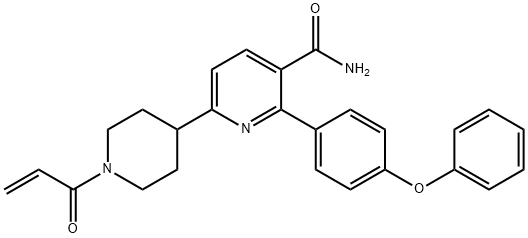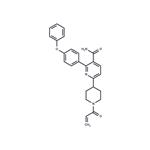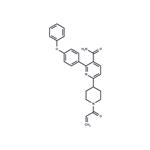
Orelabrutinib
- Product NameOrelabrutinib
- CAS1655504-04-3
- CBNumberCB03369553
- MFC26H25N3O3
- MW427.49
- EINECS-0
- MDL NumberMFCD32184857
- MOL File1655504-04-3.mol
Chemical Properties
| Boiling point | 646.3±55.0 °C(Predicted) |
| Density | 1.213±0.06 g/cm3(Predicted) |
| pka | 14.80±0.50(Predicted) |
| form | Solid |
| color | White to off-white |
| FDA UNII | WJA5UO9E10 |
| NCI Drug Dictionary | orelabrutinib |
Orelabrutinib Chemical Properties,Usage,Production
Description
Orelabrutinib is a small molecule inhibitor of Bruton's tyrosine kinase with potential antineoplastic activity.Description
In December 2020, orelabrutinib was approved by the China National Medical Products Administration for treating patients with relapsed/refractory MCL, CLL, and SLL. This compound is also being evaluated for the treatment of multiple sclerosis. Orelabrutinib, which has a unique pyridylcarboxamide hinge binder, showed an IC50 value of 1.6 nM in the BTK enzymatic assay. When tested against a panel of 456 kinases at 1 μM, orelabrutinib only inhibited BTK (>90%), while ibrutinib also targeted several other kinases, including EGFR, TEC, and BMX. Orelabrutinib has a favorable half-life of 4 h in healthy volunteers.1,2 It is administered orally at a daily dose of 150 mg.Uses
Orelabrutinib has been previously approved to treat patients with relapsed or refractory (R/R) mantle cell lymphoma and R/R chronic lymphocytic leukemia/small lymphocytic lymphoma.brand name
InnobrukaTMGeneral Description
Class: non-receptor tyrosine kinaseTreatment: CLL, SLL, MCL
Elimination half-life = 4 h
Protein binding = not reported
Biological Activity
Orelabrutinib (ICP-022) is a potent, orally active and irreversible inhibitor of Bruton's tyrosine kinase (BTK).Mechanism of action
Upon administration, orelabrutinib binds to and inhibits the activity of BTK. This prevents both the activation of the B-cell antigen receptor (BCR) signaling pathway and BTK-mediated activation of downstream survival pathways, inhibiting the growth of malignant B-cells that overexpress BTK.target


